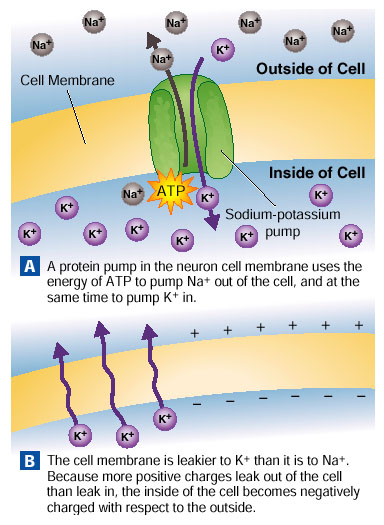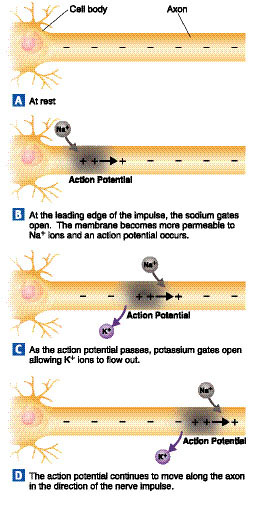Revised
text and Figure for pages 898-899 in Chapter 35 of
BIOLOGY by Miller and Levine
The
Nerve Impulse
As the Italian scientist Luigi Galvani discovered more than 200 years ago,
nerve impulses are electrical. There are important differences, however, between
between the movement of a nerve impulse and the flow of electrical current
through a metal wire. The best way to understand these differences is first
to look at a neuron at rest, one that is not carrying an impulse.
Resting
Potential
A nerve cell has an electrical potential, or voltage, across its
cell membrane of approximately 70 millivolts (mV). This might not seem like
much, but it means that this tiny cell produces a voltage roughly equal to
1/20th that of a flashlight battery (1.5 volts). Where does this voltage come
from? The potential is produced by the actions of a cell membrane pump, powered
by the energy of ATP. As shown in Figure 35-6, this membrane protein forces
sodium ions (Na+) out of the cell, and pumps potassium ions (K+) in.
 |
|
As a result of this active transport, the cytoplasm of the neuron contains more K+ ions and fewer Na+ ions than the surrounding medium. However, the neuron cell membrane is much leakier to K+ than it is to Na+. As a result, K+ ions leak out of the cell to produce a negative charge on the inside of the membrane. This charge difference is known as the resting potential of the neuron. The neuron, of course, is not actually "resting" because it must produce a constant supply of ATP to fuel active transport.
The
Moving Impulse
An impulse begins when a neuron is stimulated by another neuron or by the
environment. Once it begins, the impulse travels rapidly down the axon away
from the cell body and towards the axon terminals. As Figure 35-7 shows, an
impulse is a sudden reversal of the membrane potential. What causes the reversal?
 |
|
The neuron membrane contains thousands of protein channels or gates, that allow ions to pass through. Generally, these gates are closed. At the leading edge of an impulse, however, sodium gates open, allowing positively charged Na+ ions to flow inside. The inside of the membrane temporarily becomes more positive than the outside, reversing the resting potential. This reversal of charges is called an action potential. As the action potential, potassium gates open, allowing positively charged K+ ions to flow out. This restores the resting potential so that the neuron is once again negatively charged on the inside of the cell membrane and positively charged on the outside.
A nerve impulse is self-propagating.
That is, an impulse at any point on the membrane causes an impulse at the
next point along the membrane. We might compare the flow of an impulse to
the fall of a row of dominoes. As each domino falls, it causes its neighbor
to fall. Then, as the impulse passes, the dominoes set themselves up again,
ready for another action potential.
Change to text made by Ken Miller on 6/10/92.
Return to BIOLOGY Home Page
millerandlevine.com